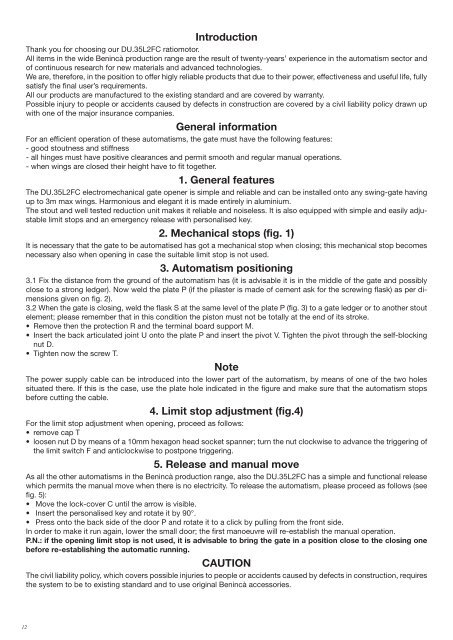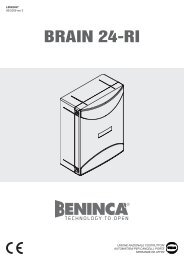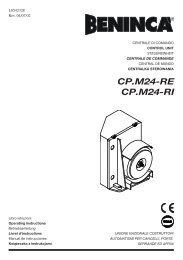DU.35L2FC - TAS Unger OG
DU.35L2FC - TAS Unger OG
DU.35L2FC - TAS Unger OG
Create successful ePaper yourself
Turn your PDF publications into a flip-book with our unique Google optimized e-Paper software.
12<br />
Introduction<br />
Thank you for choosing our <strong>DU.35L2FC</strong> ratiomotor.<br />
All items in the wide Benincà production range are the result of twenty-years’ experience in the automatism sector and<br />
of continuous research for new materials and advanced technologies.<br />
We are, therefore, in the position to offer higly reliable products that due to their power, effectiveness and useful life, fully<br />
satisfy the final user’s requirements.<br />
All our products are manufactured to the existing standard and are covered by warranty.<br />
Possible injury to people or accidents caused by defects in construction are covered by a civil liability policy drawn up<br />
with one of the major insurance companies.<br />
General information<br />
For an efficient operation of these automatisms, the gate must have the following features:<br />
- good stoutness and stiffness<br />
- all hinges must have positive clearances and permit smooth and regular manual operations.<br />
- when wings are closed their height have to fit together.<br />
1. General features<br />
The <strong>DU.35L2FC</strong> electromechanical gate opener is simple and reliable and can be installed onto any swing-gate having<br />
up to 3m max wings. Harmonious and elegant it is made entirely in aluminium.<br />
The stout and well tested reduction unit makes it reliable and noiseless. It is also equipped with simple and easily adjustable<br />
limit stops and an emergency release with personalised key.<br />
2. Mechanical stops (fig. 1)<br />
It is necessary that the gate to be automatised has got a mechanical stop when closing; this mechanical stop becomes<br />
necessary also when opening in case the suitable limit stop is not used.<br />
3. Automatism positioning<br />
3.1 Fix the distance from the ground of the automatism has (it is advisable it is in the middle of the gate and possibly<br />
close to a strong ledger). Now weld the plate P (if the pilaster is made of cement ask for the screwing flask) as per dimensions<br />
given on fig. 2).<br />
3.2 When the gate is closing, weld the flask S at the same level of the plate P (fig. 3) to a gate ledger or to another stout<br />
element; please remember that in this condition the piston must not be totally at the end of its stroke.<br />
• Remove then the protection R and the terminal board support M.<br />
• Insert the back articulated joint U onto the plate P and insert the pivot V. Tighten the pivot through the self-blocking<br />
nut D.<br />
• Tighten now the screw T.<br />
Note<br />
The power supply cable can be introduced into the lower part of the automatism, by means of one of the two holes<br />
situated there. If this is the case, use the plate hole indicated in the figure and make sure that the automatism stops<br />
before cutting the cable.<br />
4. Limit stop adjustment (fig.4)<br />
For the limit stop adjustment when opening, proceed as follows:<br />
• remove cap T<br />
• loosen nut D by means of a 10mm hexagon head socket spanner; turn the nut clockwise to advance the triggering of<br />
the limit switch F and anticlockwise to postpone triggering.<br />
5. Release and manual move<br />
As all the other automatisms in the Benincà production range, also the <strong>DU.35L2FC</strong> has a simple and functional release<br />
which permits the manual move when there is no electricity. To release the automatism, please proceed as follows (see<br />
fig. 5):<br />
• Move the lock-cover C until the arrow is visible.<br />
• Insert the personalised key and rotate it by 90°.<br />
• Press onto the back side of the door P and rotate it to a click by pulling from the front side.<br />
In order to make it run again, lower the small door; the first manoeuvre will re-establish the manual operation.<br />
P.N.: if the opening limit stop is not used, it is advisable to bring the gate in a position close to the closing one<br />
before re-establishing the automatic running.<br />
CAUTION<br />
The civil liability policy, which covers possible injuries to people or accidents caused by defects in construction, requires<br />
the system to be to existing standard and to use original Benincà accessories.







